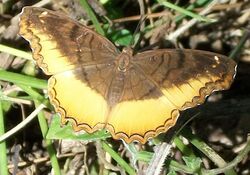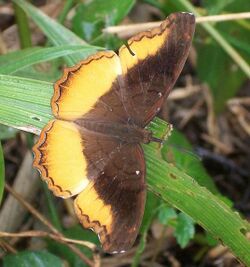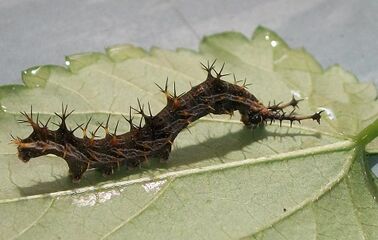Biology:Eurytela dryope
| Golden piper | |
|---|---|

| |

| |
| E. d. angulata, both from Ilanda Wilds, KwaZulu-Natal, South Africa | |
| Scientific classification | |
| Domain: | Eukaryota |
| Kingdom: | Animalia |
| Phylum: | Arthropoda |
| Class: | Insecta |
| Order: | Lepidoptera |
| Family: | Nymphalidae |
| Genus: | Eurytela |
| Species: | E. dryope
|
| Binomial name | |
| Eurytela dryope (Cramer, [1775])
| |
| Synonyms | |
| |
Eurytela dryope, the golden piper, is a butterfly of the family Nymphalidae, found in Sub-Saharan Africa, the Arabian peninsula and Madagascar .[1]
Description
Wingspan: 40–50 mm in males and 45–55 mm in females.[2] The male and female are very similar in appearance.[3] The upperside of the wings is dark brown with a wide, yellow-orange band in the lower two-thirds of the forewing margin and the outer half of the hindwing.[3] The underside of the wings is variegated in shades of brown.[3]
Subspecies
Listed alphabetically:[1]
- E. d. angulata Aurivillius, 1898 – eastern and southern Democratic Republic of the Congo, Angola, Uganda, Ethiopia, Kenya, Tanzania, Malawi, Zambia, Mozambique, Zimbabwe, Botswana, Eswatini, South Africa: Limpopo, Mpumalanga, North West, Gauteng, KwaZulu-Natal and Eastern Cape
- E. d. brittoni Gabriel, 1954 – south-western Saudi Arabia, Yemen
- E. d. dryope (Cramer, [1775]) – Guinea, Sierra Leone, Liberia, Ivory Coast, Ghana, Togo, Benin, southern Nigeria, Cameroon, central and northern Democratic Republic of the Congo
- E. d. lineata Aurivillius, 1898 – Madagascar, Comoros
Distribution
E. d. angulata is found in Ethiopia, East Africa, southern DRC, Angola[1] and on the eastern side of South Africa from Limpopo, the Magaliesberg,[3] Mpumalanga, Eswatini, KwaZulu-Natal, to Port St Johns[3] in the Eastern Cape.[4] A photographic record was made further south than Port St Johns during the South African Butterfly Conservation Assessment.[4] E. d. brittoni is found in the south-west of the Arabian peninsula.[1] E. d. dryope from Sierra Leone to Cameroon and northern DRC.[1] E. d. lineata is found in Madagascar .[1]
Life cycle
Eggs
The eggs are covered in longitudinal rows of hairy spines.[5]
Larvae
The larvae are spiny with large head processes[5] and feed on Tragia glabrata, Dalechampia capensis, and Ricinus communis.[2]
Pupae
The pupae are greenish in colour and have greatly expanded wing cases.[5]
Adults
The flight period is year round, peaking between November and June.[2] They have a leisurely, gliding flight, settling frequently, usually with open wings.[3] The adults feed on fermenting fruit, tree sap and nectar.[5] They are found in forests and wooded, frost-free savanna.[3] This species can tolerate drier conditions than the pied piper (Eurytela hiarbas).[3]
Gallery
References
- ↑ 1.0 1.1 1.2 1.3 1.4 1.5 Eurytela at Markku Savela's Lepidoptera and Some Other Life Forms
- ↑ 2.0 2.1 2.2 Woodhall, Steve (2005). Field Guide to Butterflies of South Africa. Cape Town, South Africa: Struik. ISBN 978-1-86872-724-7.
- ↑ 3.0 3.1 3.2 3.3 3.4 3.5 3.6 3.7 Williams, M. (1994). Butterflies of Southern Africa; A Field Guide. Southern Book Publishers. ISBN:1-86812-516-5.
- ↑ 4.0 4.1 Biodiversity data provided by: Data contributors to the Southern African Butterfly Conservation Assessment (SABCA) (list of contributors accessible here: http://sabca.adu.org.za/thanks.php),[yes|permanent dead link|dead link}}] a joint project of the South African National Biodiversity Institute, the Animal Demography Unit, University of Cape Town, and the Lepidopterists' Society of Africa (accessed via SABCA's online virtual museum, [1] 28-02-2011).
- ↑ 5.0 5.1 5.2 5.3 Woodhall, S. (2008). What's that Butterfly?. Struik Publishers, Cape Town. ISBN:978-1-77007-486-6.
Wikidata ☰ Q5414138 entry
 |






